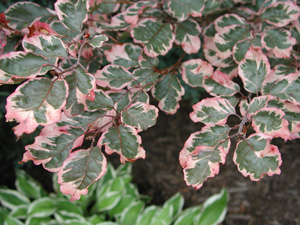Resource Library
Plant of the Week: European Beech
The University of Arkansas System Division of Agriculture does not promote, support or recommend plants featured in "Plant of the Week." Please consult your local Extension office for plants suitable for your region.
Plant of the Week
European Beech
Latin: Fagus sylvatica

Lust will get you in trouble every time. Having just returned from visiting a few mountain gardens of North Carolina, I find myself with a bad case of plant envy. European beeches, Fagus sylvatica are my latest craving and I just happen to know that one of the local big box stores inexplicably has an astonishingly good assortment of trees at always affordable prices.
European beech – with its many stately and unique cultivars – is one of a dozen species of closely related trees of the Fagus family found in the Northern Hemisphere in Europe, Asia and North America. A mature beech of any species is enough to take one’s breath away when you encounter it unexpectedly, but the European beech with its many selections is the most cherished in gardens for it comes in an astounding array of shapes, sizes and colors.
Beeches are large deciduous, low-branched trees with rounded crowns capable of reaching 50 feet in height with a spread of 30 feet, but cultivars render any size designation meaningless.
Weeping forms take on the appearance of a living waterfall while sentinel trees look like living exclamation marks in the landscape. Leaf color varies from a green-gray to deep purple to variegated to golden, all depending on the characteristics of the cultivar. Only cultivars are offered in the nursery trade and there are at least 50 of these from which to choose.
In the wintertime, beeches have long, pointed cigar-shaped buds that make the tree easy to identify. The winter buds and the smooth gray easily defaced bark make the beeches easy to spot in the winter landscape. In the summer, the European beech and the American beech are similar in appearance but Fagus grandiflora, the American beech, has prominently serrate leaves whereas the European beech has an undulate margin without prominent serrations. Beeches are shallow-rooted and produce heavy shade, so getting anything save a few early bulbs to grow beneath them, is a challenge.
European beech is the most common of the genus in gardens because it is considered the easiest species to grow, yet for every 10 beeches planted probably only one will live long enough to attain any stature in the garden. Should you live in an area from Boston to Washington D.C., or in the Pacific Northwest, this pessimistic view is not warranted but for much of the rest of the country it seems to be true. In all the thousands of miles I’ve driven in Arkansas I’ve yet to see a specimen-sized European beech in a landscape.
But this poor track record doesn’t stop me from trying. In their native clime, the European beech is centered in France and Germany with stands that go north into England and the Scandinavian countries and, to a lesser extent, south towards the Mediterranean.
The majority of the common cultivars are old clones that date back centuries and originated in the moist, cool countries of Germany, France or England. The maritime climate of this region – best represented in the US along the coastal region of the northeastern states and the Pacific Northwest – is typified by light but evenly spaced rainfall, moderate summer temperatures (both day and night) and cool, moisture-laden breezes.
If we are to attempt to provide similar conditions for the European beech we must recognize that not every site in Arkansas is suitable for the tree. Ideally a sloping site with a north or east face should be selected because such sites pick up less summertime heat than slopes facing south or west. A high canopy of trees – oaks or loblolly pines preferably – would give some shade and keep the tree cooler during the stressful summer months. In their native habitat, young beeches often succumb to heat and drought in forest settings unless provided an overstory of trees to protect them during the establishment phase. Finally, an irrigated site seems to be an absolute requirement because shallow rooted beeches have poor drought tolerance. And, should you be lucky enough to have the perfect site, remember that beeches are slow growing with 10-year-old trees only 10 to 12 feet tall.
European beech is hardy in zones 4 through 7 with summer temperatures being more challenging than winter cold. It tolerates a wide pH range but with preference for slightly acidic to slightly alkaline conditions. Rich, deep, well-drained soils are most to their liking. Though growing beeches is not for the faint of heart or easily discouraged, the payout – should you be lucky enough to succeed – will be something your grandchildren will enjoy.
By: Gerald Klingaman, retired
Retired Extension Horticulturist - Ornamentals
Extension News - June 22, 2012
The University of Arkansas System Division of Agriculture does not maintain lists of retail outlets where these plants can be purchased. Please check your local nursery or other retail outlets to ask about the availability of these plants for your growing area.